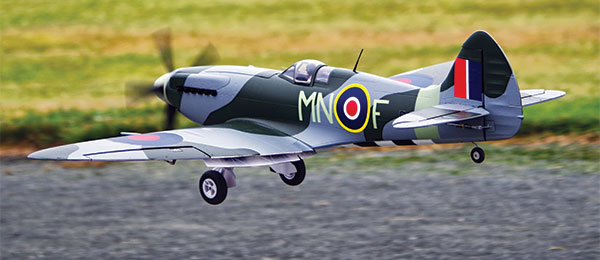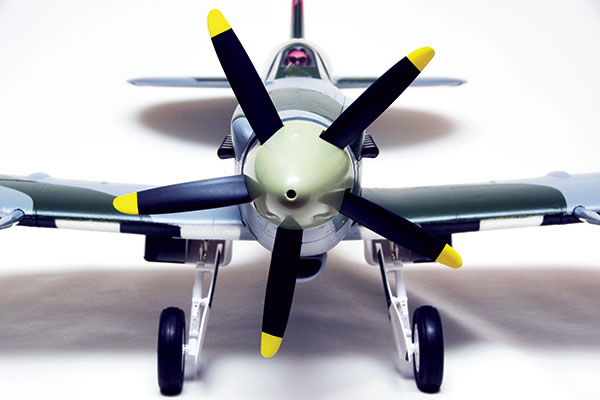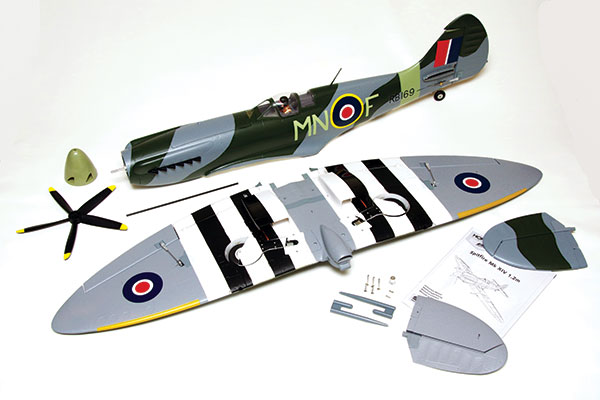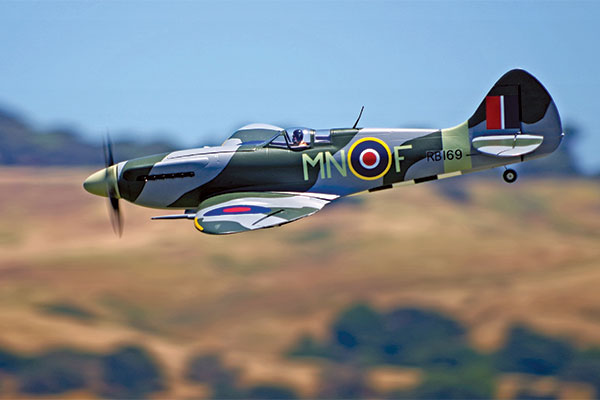E-flite Spitfire Mk XIV 1.2M BNF Basic

Written by Jon Barnes Fly a foam warbird with the RAF Product review Photos by the author As seen in the November 2016 issue of Model Aviation.
Specifications
Model type: Foam electric warbird Skill level: Beginner to intermediate Wingspan: 47.25 inches Wing area: 416.9 square inches Length: 42.32 inches Weight: 53.5 ounces Power system: Brushless electric motor Radio system: Full-range six-plus-channel transmitter with Spektrum DSMX/DSM2 technology (required); Spektrum AR636A six-channel DSMX 2.4 GHz receiver with embedded AS3X and SAFE technology (included) Construction: Z-Foam Street price: $269.99Test-model details
Motor: E-flite BL15 850 Kv brushless outrunner Speed controller: E-Flite 40-amp brushless with BEC Battery: E-flite 3S 11.1-volt 30C 2,200 mAh LiPo Propeller: Five-blade 10 x 8 Radio system: Spektrum DX9 nine-channel 2.4 GHz transmitter; Spektrum AR636A 2.4 GHz six-channel receiver Ready-to-fly weight: 53.5 ounces Flight duration: 6 to 7 minutesPluses
• Five-blade propeller mimics that used on full-scale Mk XIV. • Four-panel split flaps. • Pilot can enable or disable the SAFE feature as needed. • Embedded AS3X stabilization makes for amazing tracking and stability.Minus
• Model’s performance at full throttle might leave some pilots wishing for more.Bonus video
Product review
Boy (or girl) goes into a hobby shop. Boy sees cool-looking RC warbird. Boy buys warbird. Boy tries to fly warbird on his own without seeking the help of a competent pilot. Boy makes the walk of shame after one short flight and takes his confetti-foam warbird home in a small bag. This short and sad story is true. It has been repeated innumerable times by an impossibly great number of boys, girls, men, and even women who try to enter the world of RC aircraft without seeking the tutelage of a veteran pilot. One reason for the carnage is that, like metal to a magnet, potential new pilots are usually drawn to the more realistic-looking and exciting appearance offered by Scale warbird model aircraft. When given the chance, hobby veterans have for decades faithfully endeavored to steer newer pilots into a more beginner-friendly trainer aircraft—typically a lightly loaded, high-wing, and tricycle-gear-equipped model. Warbird models typically require at least an intermediate level of piloting proficiency. The higher wing loading commonly inherent to a warbird results in a higher stall speed that will often cause an inexperienced pilot trouble. Add in the fact that the majority of the historically famous propeller-driven fighter airplanes were tail-draggers, and it’s easy to see why new pilots are usually advised to avoid flying warbirds until they have adequately developed their piloting skills. An evolution in engineering throughout the last decade at the E-flite headquarters might ultimately be leading to a renaissance in what new pilots can expect to fly as their first or second models. With its recently released 1.2-meter wingspan, Z-Foam-composite Spitfire Mk XIV, E-flite appears to be squarely focused and doggedly determined to allow newer pilots to have their way with a warbird—no walk of shame or trash bag required. How does E-flite do it? It takes the same approach used in many of today’s full-scale military jets: stuffing a bunch of sensors and advanced technology inside of an airframe. Some of the world’s premier fighter jets use fly-by-wire control systems. With this type of system, pilots do not directly manipulate the control surfaces. Their control inputs are instead fed into the aircraft’s computer systems, which then process the commands and transmit the necessary and appropriate outputs to the aircraft’s control surfaces. In a somewhat similar manner, E-flite has come up with several advanced systems that can effectively restrict newer pilots from over-controlling a model or allowing it to get into a compromising orientation that could serve as a precursor to a crash. The 1.2-meter, Z-Foam-composite Spitfire benefits from Spektrum’s SAFE and AS3X technologies. The former system is either enabled or disabled during the binding of the receiver, and limits the airplane’s bank and pitch angles. Release both sticks and SAFE will automatically return the model to a wings-level orientation. The Spitfire can even be configured so that the SAFE system can be switched on and off at will while the Spitfire is in flight. The specific version of a Spitfire in which E-flite chose to cloak all of its high-tech wizardry is the Mark XIV. This iteration of the famous British elliptical-wing fighter flown by the Royal Air Force (RAF) featured an improved Rolls-Royce Griffon engine that was equipped with a two-stage supercharger. This powerplant was capable of propelling the Spitfire to speeds of nearly 450 mph. E-flite faithfully models the five-blade Rotol propeller used on the full-scale Mk XIV. The smooth finish of this Z-Foam airframe features a nicely applied European Theater of Operations-based camouflage trim scheme, with orientation-enhancing black and white D-Day invasion stripes applied to the model’s underside. Multipaneled split flaps, electric retracts, and a detailed pilot figure all combine to make this Spitfire an eye-catching and exciting-looking warbird model!
E-flite’s choice of a five-blade propeller accurately models the large-diameter Rotol propellers used on full-scale Mark XIV Spitfires.

The Spitfire’s narrow-set main gear are fired by dependable E-flite electric retracts.
Construction
This BNF model features a glueless assembly. A half-dozen small fasteners are all that stand between the individual components and the transformation of a fully assembled and flight-ready model. If a pilot opts to install the plastic gun details in the leading edges of the wing, a few small dabs of adhesive will be required. If the binding procedure normally used with Spektrum radio-equipped models is followed, the SAFE system defaults to a disabled state. Activating it requires a slightly different binding procedure. When activated, a switch on the transmitter can be configured to turn SAFE on and off during flight. While performing the initial transmitter programming and setup of my Spitfire, one of the flap servos suddenly went to one end of its travel and began to overheat. A quick call to Horizon Hobby’s customer service had a replacement servo on my doorstep two days later. Replacing the servo required that the underwing scoop, which lies directly on top of the flap servo, be carefully extricated and then reglued back into position.
Pilots who are short on time can fly through the assembly of this low parts-count BNF kit.
Flying
Initial flight testing was performed with the SAFE feature completely disabled. Although half-flap takeoffs require the usual attention to the rudder quadrant, the tail surfaces quickly gain authority. With the Spitfire up on the main landing gear, keeping the model’s nose aligned with the centerline of the runway becomes even easier. Although the narrow stance of the main gear suggests challenging takeoff runs, deliberate gradual application of takeoff power tames this potential tiger. With takeoff flaps left in and the gear retracted, this model can be flown around the pattern at an amazingly slow pace. Dropping the flaps to the landing position slows the Spitfire even further. The embedded AS3X stabilization system does a fantastic job of mitigating most of the airframe’s unsettling effects of wind and rising warm air. With the airframe cleaned up and the throttle pushed full forward, the cool-looking, five-blade propeller pulls the Spitfire along at a scalelike pace. The multiblade, yellow-tipped propeller circle created by this scalelike propeller cannot be beat. Pilots who prefer their fighters fast and furious might find that the top end of this model leaves them wanting more. With the rates clicked over to high, the Spitfire can rumble and tumble with the best of them. Warbird aerobatics can be performed at a scalelike speed. There is perhaps no better testimony to the in-flight behavior of a model than a pilot feeling comfortable enough to make low-level inverted passes a scant few feet above the ground on a maiden flight! This model looks especially impressive when the flaps are fully deployed and the landing gear is down and locked in preparation for landing. Pilots will need to ensure that they maintain an appropriate amount of airspeed on final approach, pushing the nose down slightly if necessary to keep the model comfortably above stall speed. Let the Spitfire get too slow on final and the model might drop the last foot or two onto the runway surface. Manage the throttle and nose all the way in and the Spitfire will land on the main landing gear every time! Phase two of the flight testing involved activation of the SAFE system. Pilots using a transmitter with seven or more channels can select and use one of the transmitter switches to activate or disable the feature at any point during the flight. Pilots using a six-channel system will be somewhat limited when it comes to assigning a switch to activate/deactivate SAFE mode. In this case, SAFE can be configured to be active when the landing gear or flaps are lowered. Retracting the gear or flaps will then turn the SAFE system off. Using a DX9 transmitter, a custom voice annunciation can be programmed to audibly call out whether the SAFE system is on or off. Flying the Spitfire with SAFE activated substantially reduces a pilot’s workload. The system limits the maximum bank and pitch angles and attempts to maintain level flight when the sticks are released. The system can effectively filter out many of the excessive control inputs typically made by nervous, newer pilots.
The embedded AS3X stabilization and optionally available pilot-activated SAFE mode make this warbird one that can be flown by less experienced modelers.
Takeoffs made when SAFE is activated require less corrective input on the rudder to keep the model tracking straight down the runway. Landings made in SAFE mode active come with the added benefit of helping newer pilots fly a nice and large approach pattern. Restricted bank angles prevent aeromodelers from shooting a rushed short approach with tight turns, which is usually a recipe for disaster. Pilots instead must perform a landing approach built on flying a larger approach pattern, with gradual and sweeping turns connecting each leg. SAFE not only potentially lightens a newer pilot’s workload in the critical and often situationally overwhelming landing phase, but helps to teach him or her that the best landings start with a planned, deliberate approach. The assembly manual recommends an initial countdown timer of five minutes. Flights made with a mixture of full-throttle passes on the deck, mid-throttle inverted passes, easy aerobatics, and a few circuits around the landing pattern shooting touch-and-gos resulted in flight durations of up to seven minutes. This model managed to squeeze in several flights from a mere three-cell 2,200 mAh LiPo battery pack!










2 comments
Am about to fly this for the
Hello! my name is jonathan.
Add new comment